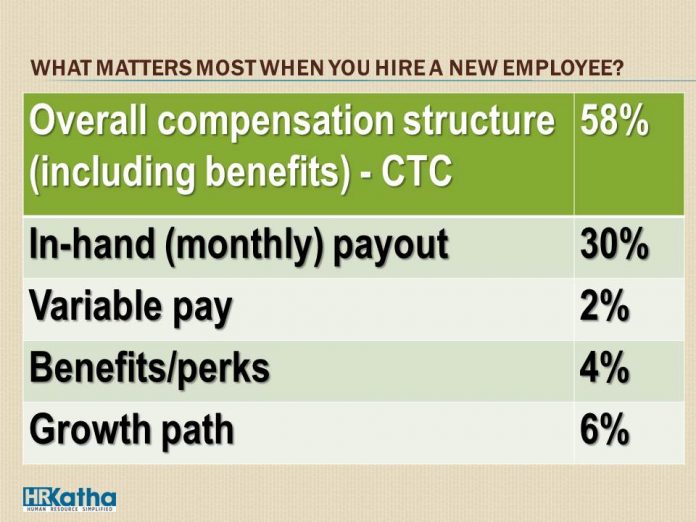While take-home salary has emerged as the common preferred salary component, there are distinct differences in other perks desired.
Compensation conversations have been the tipping point for the Indian workforce for the longest time. With most of today’s workforces comprising baby boomers, Gen X and Y, it is natural that employees from different generations have different preferences in the compensation components, based on their unique requirements.
There have been instances of people choosing transport allowance and meal allowance over gratuity and PF money, or someone preferring to better health insurance coverage for the family while negotiating the package.
While retaining employees, monetary components take a back seat and career growth path emerges as a more important factor.
The same was corroborated by a recent TimesJobs.com Compensation and Benefit study that surveyed over 1,000 employers. 70 per cent of the organisations stated that there is a distinct difference in preferences when it comes to compensation components among various age groups. However, even as take-home salary has emerged as the common preferred salary constituent among employees across generations there are distinct differences in other perks desired.
Be it the rising inflation or the increasing cost of living, the survey revealed that employees, irrespective of age, prefer a higher ‘in-hand’ pay as compared to other components of salary. Nearly 40 per cent baby boomers, 56 per cent Gen X and 41 per cent Gen Y workforce seek better cash-in-hand. This desire is more at the junior level, with nearly 60 per cent of the low-ranking employees seeking more in-hand salary.
Furthermore, the study shows that the importance of other benefits, beside the cash-in-hand element, depends on which generation the professional belongs to. For instance, the baby boomers, owing to their proximity to retirement, give more importance to post retirement benefits after the in-hand salary in their compensation and benefits package. Nearly 38 per cent baby boomers seek retirement benefits.
Interestingly, post-retirement benefits are the second most sought after compensation component for Gen X and Gen Y workforce as well. Nearly 26 per cent Gen X and 23 per cent Gen Y workforce also seek retirement benefits from their salary package. This busts the popular notion that the younger generation of employees are not concerned about securing their future. They only want quick monetary benefits from their job.

According to the survey, organisations also have varying priorities regarding different aspects of compensation and benefits, depending on whether they are hiring a new employee or retaining an existing one. The theory of ‘one size fits all’ does not apply anymore as managers have to factor in business needs to decide what matters more. 58 per cent employers agreed that overall compensation structure or CTC, is what matters the most when hiring a candidate , while 20 per cent felt that in-hand (monthly) payout was most important.
However, while retaining employees, monetary components take a back seat and career growth path emerges as a more important factor, say 56 per cent employers. This is followed by the overall compensation structure (16 per cent) and other benefits and perks (14 per cent).
“While ‘take-home’ remains of prime importance in evaluating compensation, other factors, such as growth prospects, future earning potential, performance-based allowances, ESOPs, housing, schooling, medical, and other benefits play an important role as well. TimesJobs has created a vast database of company reviews by genuine employees. This also includes industry-scale salary benchmarking tools that give insights into a company’s compensation philosophy, allowing candidates a transparent view of their potential employers,” says Nilanjan Roy, head of strategy, Times Business Solutions.
Another TimesJobs poll further revealed that almost 90 per cent employees prefer a customised compensation package. Their priority of what is more important to them depends on the stage of their career and their age. On a closing note, Roy says, “Organisations must consider tailoring their compensation structure for employees. But to do so they must understand the unique attributes and aspirations of the different workforce generations. To effectively manage a multigenerational workforce, the employers must start by getting to know the expectations of their workforce.”
Value our content... contribute towards our growth. Even a small contribution a month would be of great help for us.
Since eight years, we have been serving the industry through daily news and stories. Our content is free for all and we plan to keep it that way.
Support HRKatha. Pay Here (All it takes is a minute)




































